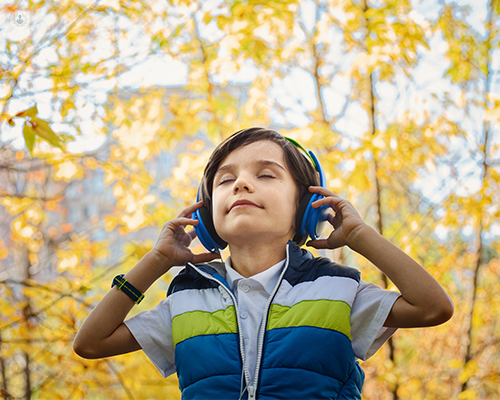Acquired hearing loss in children – everything you need to know
Written by:Loss of hearing in children can occur because of a number of different factors. Experienced paediatric otolarynologist, Mr Christopher Pepper explains all you need to know about this condition, including causes, warning signs and treatment options

What exactly is acquired childhood hearing loss?
Acquired childhood hearing loss is a problem with a child’s hearing that develops due to various causes. Hearing loss present at birth is called congenital hearing loss.
Who does it primarily affect?
Acquired hearing loss can affect children at any age from newborn right through to teenage years, for example if related to wax build-up in the ear canal. The most commonly affected ages are between 1-7 years old, due to ear infections and fluid build-up in the ear (glue ear).
What are the signs and symptoms of hearing loss in infants and children?
Infants
- Not startling to sound or turning to a source of sound by around 6 months of age
- Delayed development of single words which are expected around 12 months of age
- Not responding to their name when called
- Balance problems and delayed walking
Children
- Not responding to their name when called
- Delayed development of speech or unclear speech/pronunciation
- Concerns raised at nursery and school about hearing
- Loud speech
- TV/tablet volume raised louder than other friends and family
- Direct complaint of hearing difficulty – e.g., in a children’s playground
What are the main causes of acquired hearing loss in children?
The hearing system is described in three separate areas:
- Outer ear – external ear and ear canal
- Middle ear – ear drum, middle ear cleft (air filled space behind the ear drum), 3 ossicles (vibrating bones of the ear also behind the ear drum)
- Inner ear – cochlea (hearing), semi-circular canals (balance), vestibular and cochlear nerves
The main causes of hearing loss are:
- Outer ear – wax build up or ear canal infection which blocks the transmission of sound
- Middle ear – fluid (glue ear) or infection in the middle ear which acts as a muffler and reduces the transmission of sound vibrations
- Problems with the ear drum or vibrating bones of the ear
- Inner ear – severe infections, injury, genetic problems, tumours
What types of hearing tests are available?
Generally hearing testing for children requires a specialist audiology team as a child’s stage of development can influence the results.
OAEs (otoacoustic emissions) – Soon after birth all children in the UK undergo screening for hearing loss with this test, which uses ear plugs and an automated machine to look at the hearing pathway from the outer ear, through the eardrum, to cochlea.
Auditory brainstem response (ABR) – Any age - used less frequently and usually under general anaesthetic, it detects very small electrical signals in the brain when sounds are heard.
Visual reinforcement audiometry (VRA) – from age 6 months – 2 years old. This is performed in a specially designed room, with the help of lights and toys, looking at the response and head turning of children to various sounds
Play audiometry – from age 20 months – 5 years old. This is performed in a specially designed room, where children must follow a simple instruction when various sounds are heard.
Pure tone audiometry – from around 5 years old upwards. Tones of varying frequency and intensity are played through headphones, and the child presses a button when sounds are heard.
How is it treated/managed and will their hearing ever return to normal?
Treatment is possible for most causes of childhood hearing loss, and most children’s hearing can be returned to normal. The cause of any hearing loss needs to be diagnosed accurately, and then treatment targeted to this cause.
- Ear wax can be removed, usually in the clinic.
- Infections may resolve spontaneously, or may require antibiotics, and hearing usually returns to normal once resolved.
- Grommets (a small ventilation tube in each ear drum) can be placed in a short operation under general anaesthetic. This can reverse glue ear and usually normalise the hearing. It often improves ear infections as well.
- Problems with the eardrum and vibrating bones of the ear can often be improved during an operation.
- Many types of hearing aids are available and can often make sounds louder and easier to hear.
- Speech and language therapy and education can help children learn to communicate and develop.
Mr Christopher Pepper is a consultant paediatric ENT surgeon based in central London. You can book an appointment with him here.


